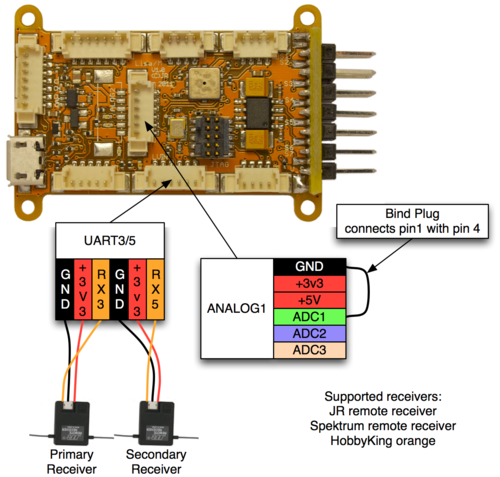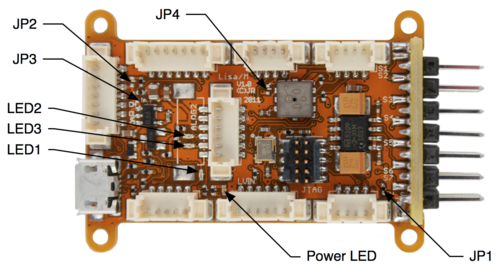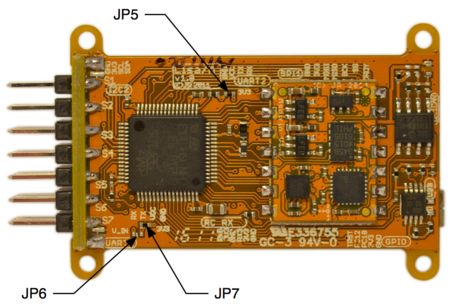Difference between revisions of "Lisa/M/Tutorial/FixedWing"
(→Servos) |
|||
| (5 intermediate revisions by 3 users not shown) | |||
| Line 1: | Line 1: | ||
<div style="float: right; width: 15%"><categorytree style="float:right; clear:right; margin-left:1ex; border: 1px solid gray; padding: 0.7ex;" mode=pages>Tutorial</categorytree></div> | |||
= Intro = | = Intro = | ||
| Line 7: | Line 9: | ||
1x Mentor RC Aircraft | 1x Mentor RC Aircraft | ||
1x XBee | 1x XBee XSC Modem | ||
1x RC Receiver | 1x RC Receiver | ||
| Line 53: | Line 55: | ||
=== PPM Receiver === | === PPM Receiver === | ||
A modified RC receiver with full PPM out can be used to control the AP board from the ground. How to get a receiver with full PPM out or modify an existing one [http://paparazzi.enac.fr/wiki/RC_Receivers_and_Radios# | A modified RC receiver with full PPM out can be used to control the AP board from the ground. How to get a receiver with full PPM out or modify an existing one [http://paparazzi.enac.fr/wiki/RC_Receivers_and_Radios#PPM_Receivers can be found here.] | ||
=== Satellite Receiver === | === Satellite Receiver === | ||
| Line 98: | Line 98: | ||
== IMU Calibration == | == IMU Calibration == | ||
Using default settings is always better than '''badly''' caliberated sensors. Having stated that, and if you didn't make the board yourself, then you probably got a calibration file (.xml) from your board supplier. If you didn't receive a calibration file then follow the steps for [http://paparazzi.enac.fr/wiki/ImuCalibration onboard IMU calibration]. If you follow that path, make sure your calibration is very meticulously done. | |||
= Pre-flight Checklist= | = Pre-flight Checklist= | ||
| Line 108: | Line 108: | ||
This page does not contain information about flying the aircraft. A look around on this wiki or elsewhere on the internet can help you out. | This page does not contain information about flying the aircraft. A look around on this wiki or elsewhere on the internet can help you out. | ||
[[Category: | [[Category:Tutorial]] | ||
Latest revision as of 15:01, 17 May 2014
Intro
This article is meant as a tutorial on how to assemble, wire up, and mount devices in a fixed wing aircraft based on Lisa/M for a maiden flight on Autopilot. We will use a Multiplex Mentor as example.
For this we need:
1x Mentor RC Aircraft
1x XBee XSC Modem
1x RC Receiver
1x uBlox LEA5 GPS module
Setup Hardware
To test hardware, supply VIN with 5-7V from a Battery Eliminator Circuit (BEC). This is much safer and more power efficient. Plug in your battery into VBATT which will let the Lisa/M monitor the actual battery voltage. The allowed power range is 5V through to something over 20V, apparently, but something like 11-16V is around the range you get from 3 or 4 cell LiPo batteries.
Also, make sure that if your avionics are powered up that your remaining electronics are not floating at battery + voltage level. This can happen if you power Lisa/M separately from your motor controllers for example. It either may happen that you connect your battery to the motor controllers high side first or you have a N-Fet switch that is disconnecting ground. (Courtesy of Esden)
When limiting the current via a power supply, ampere ratings shouldn't be too important as long as it isn't too low. The board takes what it needs. Normal operation with XBee, Spektrum Satellite, and GPS attached seems to draw ~200 mA.
IMU
The Lisa/M can be purchased with the Aspirin IMU already soldered to it. Otherwise, you can solder an Aspirin IMU on it yourself.
GPS
On connector UART1 we will connect the GPS receiver. A uBlox LEA-5H will be uses in the basic setup
Servos
ESC
The ESC which stand for Electronic Speed Control to contol the motor speed will be connected to servo pins S1. We will also solder the VBAT connection to the positive battery terminal from the ESC so Lisa/M can monitor the battery voltage.
Aileron
To Pin S2 we connect the left aileron servo. Left side is left is as seen from the back of the airframe. And to pin S5 we connect the right aileron cable
Elevator
On Pin S3 the Elevator servo cable
Rudder
On Pin S4 the rudder servo cable
RC Receiver
To be able to test your UAS a RC receiver comes in very handy. One must realize without a receiver an well tuned airframe can fly very well, however for initial tests adding a receiver makes life so much easier. The documentation here will describe how to connect and setup such an RC receiver.
PPM Receiver
A modified RC receiver with full PPM out can be used to control the AP board from the ground. How to get a receiver with full PPM out or modify an existing one can be found here.
Satellite Receiver
Connecting a 2.4GHz Spectrum or compatible receiver
It is very well possible to connect another 2.4Ghz receiver, however the software to interact with that device must at the moment be written by oneself. The advantage of Opensource is that it is possible. Sharing your coding work would be great and in line with the GPL license.
Telemetry
An XBee XSC wireless data module will be used to enable to receive telemetry data. While not needed for fully autonomous flight it is very beneficial to have telemetry data. We will connect the transmitter to connector UART2
Power
Jumpers
It is possible to reconfigure the electrical system on Lisa/M using the supply jumpers. On the boards the Jumper are not real jmper but a spot where we can solder or unsolder a "Bridge" to make or break the connection. In our case the ESC will supply both the servos and the board with power from the main battery. This is the default setup of Lisa/M, so there is no need to solder anything on the board.
- JP1 connects the servo power rail to V_IN rail.
- JP2 connects the battery rail (used by default only for battery voltage measurement) to the V_IN rail.
- JP3 bypasses the +5V voltage regulator and connects V_IN to the +5V rail.
- JP4 connects the V_IN rail to the VCC pin on the UART2 connector.
- JP5 connects the +3V3 rail to the VCC pin on the UART2 connector.
- JP6 connects the V_IN rail to the VCC pin on the UART1 connector.
- JP7 connects the +3V3 rail to the VCC pin on the UART1 connector.
Setup Software
Bootloader
To awake the hardware from sleep and activate the "brain" a so called "bootloader" is used. At the moment there is no bootloader code released yet for Paparazzi and this type of board. If there was, you would not need JTAG to change the software in your Lisa/M and only a USB cable would suffice to upload a new flight plan (just as it is now with a LPC21-based Paparazzi Autopilot board like the TWOG.) If you are good at writing bootloaders for the STM please add your code to the Paparazzi repository.
Uploading Firmware
For the board to perform some sort of action, a "brain" a.k.a firmware must be uploaded to the board. This is done by way of a JTAG cable or USB cable. More info on uploading firmware can be found Lisa/M#Programming. If you do not have such a cable, it is not possible to upload your flight plan firmware to the board. You can order this cable a various hardware suppliers. The cable design is also open source, you could opt to make one yourself, but that is not trivial.
IMU Calibration
Using default settings is always better than badly caliberated sensors. Having stated that, and if you didn't make the board yourself, then you probably got a calibration file (.xml) from your board supplier. If you didn't receive a calibration file then follow the steps for onboard IMU calibration. If you follow that path, make sure your calibration is very meticulously done.
Pre-flight Checklist
Double-check that you connected everything correctly. Then switch on your transmitter and power up your board.
Flying
This page does not contain information about flying the aircraft. A look around on this wiki or elsewhere on the internet can help you out.


